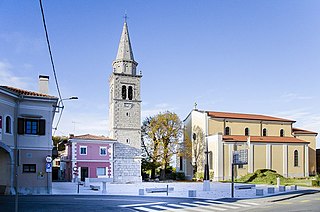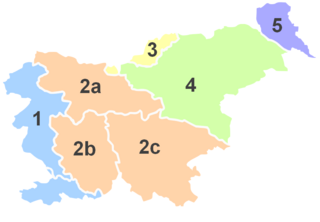The Highland Rim is a geographic term for the area in Tennessee surrounding the Central Basin. Nashville is largely surrounded by higher terrain in all directions.

The Karst Plateau or the Karst region, also locally called Karst, is a karst plateau region extending across the border of southwestern Slovenia and northeastern Italy.

Sežana is a town in the Slovenian Littoral region of Slovenia, near the border with Italy. It is the seat of the Municipality of Sežana. Sežana is located on the Karst Plateau, 17 kilometres from Trieste, Italy, and 80 km (50 mi) from Ljubljana, the capital city of Slovenia.

The Slovak Karst is one of the mountain ranges of the Slovenské Rudohorie Mountains in the Carpathians in southern Slovakia. It consists of a complex of huge karst plains and plateaus. Since 1973 it was a protected landscape area. On 1 March 2002 Slovak Karst National Park was declared. It is also a UNESCO Biosphere Reserve and part of it forms UNESCO World Heritage site Caves of Aggtelek Karst and Slovak Karst.

The Slovene Littoral is one of the five traditional regions of Slovenia. Its name recalls the former Austrian Littoral, the Habsburg possessions on the upper Adriatic coast, which the Slovene Littoral was part of.

A foiba — jama in South Slavic languages scientific and colloquial vocabulary — is a type of deep natural sinkhole, doline, or sink, and is a collapsed portion of bedrock above a void. Sinks may be a sheer vertical opening into a cave, or a shallow depression of many hectares. They are common in the Karst (Carso) region shared by Italy and Slovenia, as well as in a karst of Dinaric Alps in Bosnia and Herzegovina, Montenegro and Croatia.

The Pokljuka Plateau is a forested karst plateau at an elevation of around 1,100 to 1,400 metres, located in the Julian Alps in northwestern Slovenia. The plateau is known for its forests, mountain pastures, and winter sports facilities. It is also a common starting point for mountain hikers. The yearly Biathlon World Cup meets held at the Pokljuka Biathlon Center, 15 kilometres (9.3 mi) west of the village of Bled. Pokljuka is part of Triglav National Park. Administratively, it belongs to the municipalities of Bled, Bohinj, and Gorje.

Doberdò del Lago is a comune (municipality) in the Italian region Friuli-Venezia Giulia, located about 30 kilometres (19 mi) northwest of Trieste and about 11 kilometres (7 mi) southwest of Gorizia, and borders the following municipalities: Duino-Aurisina, Fogliano Redipuglia, Komen (Slovenia), Miren-Kostanjevica (Slovenia), Monfalcone, Ronchi dei Legionari, Sagrado, and Savogna d'Isonzo. It is located in the westernmost part of the Karst Plateau.

The Altopiano delle Murge is a karst topographic plateau of rectangular shape in southern Italy. Most of it lies within Apulia and corresponds with the sub-region known as Murgia or Le Murge. The plateau lies mainly in the Metropolitan City of Bari and the province of Barletta-Andria-Trani, but extends into the provinces of Brindisi and Taranto to the south; and into Matera in Basilicata to the west. The name is believed to originate from the Latin murex, meaning "sharp stone".

The Pešter plateau (Serbian: Пештерска висораван, romanized: Pešterska visoravan, or simply Pešter (Serbian Cyrillic: Пештер, pronounced [pɛ̌ʃtɛr], is a karst plateau in southwestern Serbia, in the Raška region. It lies at the altitude of 1150–1492 m, at 1492 meters. The territory of the plateau is mostly located in the municipality of Sjenica, with parts belonging to Novi Pazar and Tutin.

The Yunnan–Guizhou Plateau or Yungui Plateau is a highland region located in southwest China. The region is primarily spread over the provinces of Yunnan and Guizhou. In the southwest, the Yungui is a true plateau with relatively flatter highland areas, while in the northeast, the Yungui is a generally mountainous area of rolling hills, gorges, and karst topography.

Vassieux-en-Vercors is a commune in the department of Drôme in southeastern France.

Bélesta is a commune, situated on the Hers-Vif river in the Ariège department of southwestern France.
The Karst dialect, sometimes Gorizia–Karst dialect, is a Slovene dialect in the Littoral dialect group, spoken in western Slovenia and in parts of the Italian provinces of Trieste and Gorizia. It takes its name from the Karst Plateau.

The Trnovo Forest Plateau is a karst plateau that constitutes the extreme northwest end of the Dinaric Alps. The Trnovo Forest Plateau has a karst character, without surface watercourses and broken up by closed valleys, outcroppings, hills, caves, shafts, and smaller karst features: solution pans, rills, karrens, and other features. Significant karst features include ice caves. The vegetation inversion at Big Paradana Ice Cave in the eastern part of the plateau, measuring 385 meters (1,263 ft) by 1,550 meters (5,090 ft), is a locus classicus and in the past ice was harvested from it and exported via Gorizia and Trieste to Egypt.

The Lož Karst Field, also known as the Lož Valley, is a karst field in Inner Carniola in southwest Slovenia. It is the smallest karst field in Inner Carniola.
The Bločice Karst Field is a dry karst field in Inner Carniola.

The Bloke Plateau is an extensive bowl-like plateau in southwest Slovenia, part of the traditional region of Inner Carniola.

Baishiya Karst Cave is a Tibetan Buddhist sanctuary and a high-altitude paleoanthropological site located on the northeastern edge of the Tibetan Plateau in Xiahe County, Gansu, China. This karst cave is the site of the discovery of the earliest hominin fossil found on the Tibetan Plateau, the Xiahe mandible. The mandible, by way of palaeoproteomic analysis, is the first confirmed discovery of a Denisovan fossil outside of Denisova Cave. This fossil discovery shows that archaic hominins were present in a high-altitude, low-oxygen environment by around 160,000 years ago.

















